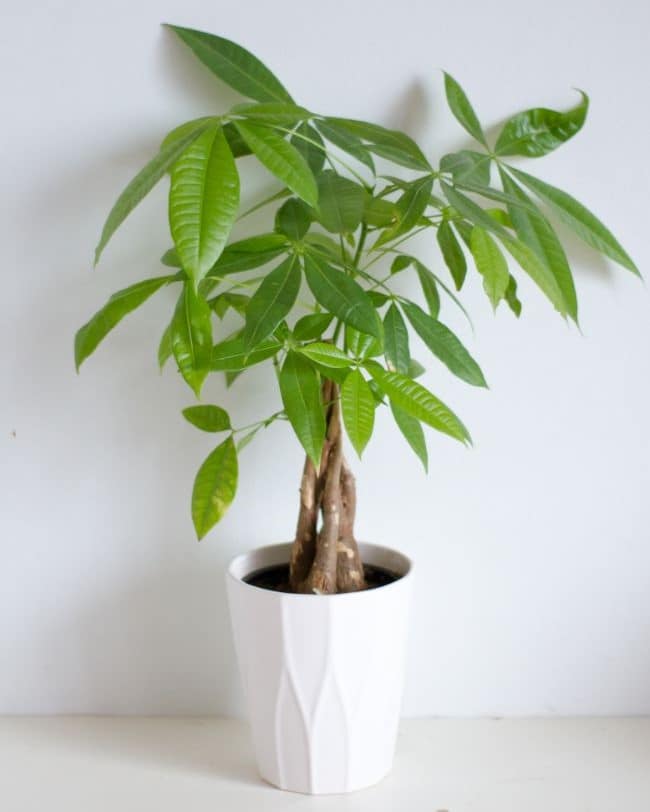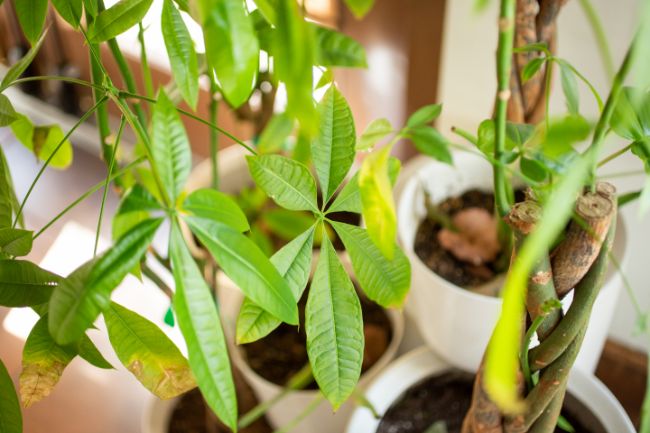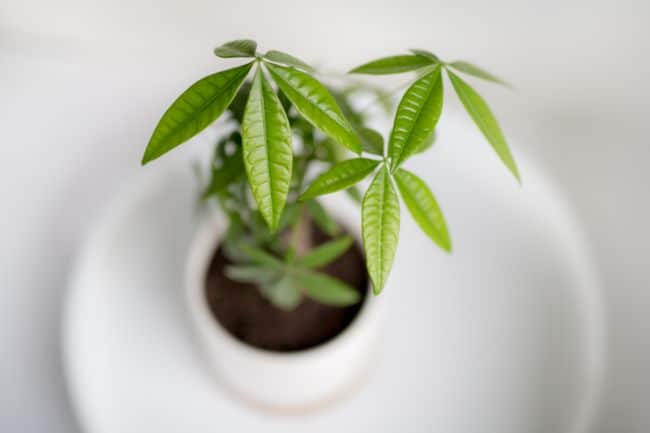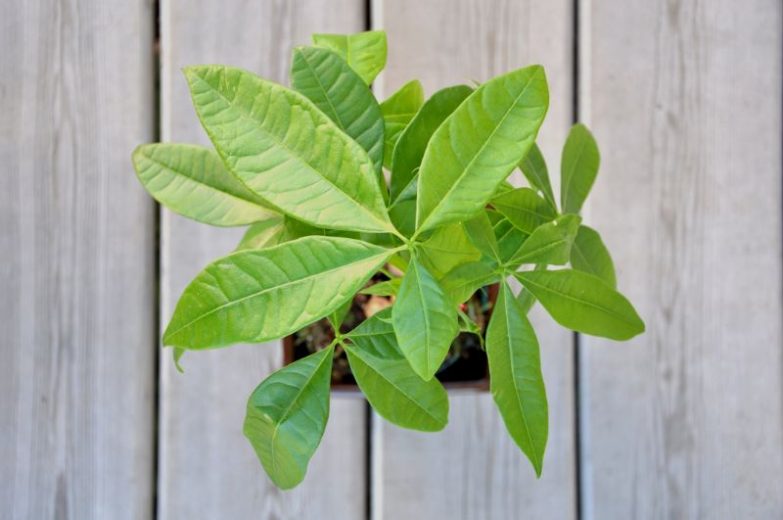Money Trees (Pachira aquatica) make perfect indoor plants, and are generally easy to care for. With large, oblong, fan-like leaves, and upright growth, they look great almost anywhere. If you find your Money Tree dropping leaves, you are not alone, as this is one of the main challenges with their care. Thankfully, it can easily be fixed and prevented.
A Money Tree dropping leaves is most commonly due to overwatering or underwatering, but multiple sources of stress will also cause leaf drop. Drafts, temperature stress, pests, acclimation, disease, repotting, or planting in an unsuitable pot or soil can also cause leaf drop.
It is usually fairly simple to stop a Money Tree dropping leaves, but it is crucial to know what the problem is, in order to be able to fix the issue. This article will discuss each cause of leaf loss and show you how to fix your plant.
9 Reasons Why Your Money Tree Is Dropping Leaves

Overwatering
If you find your Money Tree dropping leaves, your first suspicion should be overwatering, as this is the most common cause. Overwatering causes soggy soil which puts the roots of your plant under great stress, eventually leading to them developing root rot and dying.
This causes leaf loss as the plant cannot absorb water and nutrients from the affected roots to support the foliage, and your Money Tree will respond by dropping leaves.
It seems odd that water, something that is essential for healthy growth of your Money Tree can also cause your plant to suffer, but it is the old adage, that you should have everything in moderation.
How To Know If Overwatering Is Causing Your Money Tree To Lose Leaves
Overwatering is not just caused by watering too often. Any factor that leads to the soil remaining wet, or causing poor root aeration can lead to an overwatering problem. Look for the following signs that overwatering is causing your Money Tree to drop leaves.
- Generally yellowing leaves. Read more about other causes of yellow leaves on houseplants here.
- A wilting plant without evidence of underwatering.
- Soil that drains very slowly after watering
- A small plant in a large pot – The soil will take a long time to dry out after watering, increasing the risk of overwatering.
- Using a pot with minimal or no drainage holes.
- Regularly forgetting to empty the drip tray or outer pot after watering. Money trees hate their roots sitting in water.
How To Fix An Overwatered Money Tree That Is Dropping Leaves
- Do not water your plant on a schedule. Check your plant every few days, and only water once the top 1-2 inches of the soil is dry.
- Ensure sufficient light, to promote vigorous growth, so that the plant uses the available water promptly.
- If water takes a long time to drain, repot in a well-draining potting mix. Read my guide to houseplant soil for more info.
- Make sure the pot is an appropriate size for the plant.
- Make sure the pot has plenty of drainage holes and that you empty the drip tray or outer pot 5-10 minutes after watering. Read more about pots for indoor plants here.
Drafts
If you are providing generally good care, but your Money Tree is dropping leaves, think about the possibility of drafts. Hot or cold drafts will cause a lot of stress for your plant, and one response is for it to drop leaves.
A drafty window, or placing your plant near to a heating or cooling vent will be very likely to cause your Money Tree to lose leaves.
Move your plant to a location well away from any potential drafts and try to provide fairly consistent temperatures. It may take a few weeks for the plant to stabilize and stop losing leaves. Thankfully, Money Trees are quite resilient, and your plant will soon start producing new leaves to replace the ones it has lost.
Acclimation
When you bring your Money Tree home, there is a big change in the growing conditions. Your Money Tree will often respond by dropping leaves as it acclimates to the new conditions.
Part of this is a stress response, but part is how the plant adjusts to the new environment by making changes to the amount and distribution of its foliage.
Most plants that you buy will have been grown in a plant nursery that has optimized growing conditions to maximize the health and growth rate of the plant. Inevitably, most people will be unable to replicate these perfect growing conditions, so a little leaf loss can be expected.
As long as the leaf loss is only mild and is limited to the first few weeks of bringing the plant home, then all is ok. Just focus on finding a good spot for your Money Tree in your home and providing a good level of care.
If your Money Tree continues dropping leaves, go through the rest of this article to work out if there is another reason for leaf loss.

Underwatering
A Money Tree dropping leaves due to underwatering should be easy to identify. Look for dry, curling leaves, most noticable on younger leaves. The leaves may have brown tips or edges and the whole plant may even be drooping.
Give your plant a good soak and resume a normal watering regime. Check your plant every few days and water every time the top 1-2 inches of the soil feels dry. Avoid watering on a schedule, as this usually leads to watering too much or too little.
The rate of recovery of your plant will depend on how severe the underwatering has been. If your Money Tree has lost a lot of leaves, then you will have to ensure good care until new leaves appear. The good news is that your Money Tree can recover from even quite severe underwatering.
Pests
Money Trees (Pachira aquatica) are prone to sap-sucking houseplant pests such as scale, mealybugs, thrips, spider mites and aphids. You may see the pests themselves, or you may be able to find evidence of their presence. Look for small yellow or brown spots on the leaves in an irregular pattern. Severely affected leaves will usually drop from the plant.
Check the tops and undersides of the leaves and also the stems for signs of any pests. Sometimes the leaves can feel sticky due to honeydew that pests such as aphids and scale excrete. Spider mites are very tiny, so you will need to look very closely to see them, or you may see their fine, wispy webs between the foliage.
I recommend checking your houseplants on a regular basis for pests, as it is much easier to treat a mild case than have to fight a severe infestation. Read my guide to identifying and treating common houseplant pests here for more info.
Disease
Other than root rot caused by overwatering, Money Trees can also be prone to fungal and bacterial leaf spot diseases. Leaf spot diseases are much more common in wet, humid, poorly ventilated growing conditions. Optimizing watering practices and ensuring some ventilation will usually prevent most diseases.
Bacterial leaf spots usually present with wet-looking brown or black spots on the foliage that spread rapidly. Fungal leaf spots are often smaller, well defined and more numerous.
Regardless of the cause, you should carefully prune off all affected foliage with sterile pruning shears and ensure that care conditions are optimized to reduce the risk of recurrence.
You can also treat your plant with a range of anti-fungal preparations, which may reduce the risk of reinfection. You can read more about how to identify and treat houseplant diseases in this article.
Low Light
Although watering often gets the blame for many houseplant problems, insufficient light is even more crucial to their long term health. If your Money Plant is dropping leaves, make sure to think about how much light it is getting. Your Money Tree will do best in bright, indirect lighting, and this is usually brighter than most people think. Read my article that explains what bright, indirect light is and how to adjust plant location to optimize lighting.
In lower light conditions, your plant will not be able to support as much foliage, and the plant will slowly drop leaves and become increasingly leggy over time.
The best solution is to move your plant to a brighter location and optimize care. If your plant looks sparse and leggy, wait a while for new foliage to grow, before pruning to encourage more compact growth.
Temperature Stress
Money Trees (Pachira aquatica) are native to hot and humid regions of Central and South America, where the temperature is fairly consistent all year round. While they can usually tolerate higher temperatures, particularly if humidity levels are kept high, they are definitely not frost tolerant.
Exposure to temperatures of less than 30°F (-1°C) will lead to your Money Tree dropping leaves. This clearly won’t be a problem if you keep your plant indoors. However, if you like to bring your houseplants outside during the summer, make sure to bring them in again before the cold autumn evenings arrive.

Transplant Stress
If your Money Tree is dropping leaves after repotting, this is usually nothing too much to worry about. Repotting can be a stressful time for your plants, particularly if you have had to manipulate the roots much during the process.
As long as you have repotted into a suitable container and potting mix, then your plant should recover before too long. Just focus on providing good care and your Money Tree should quickly stop losing leaves and resume healthy growth.
Last Word
If your Money Tree is dropping leaves, don’t panic. Just take a little time to carefully examine your plant and the conditions it is growing in. It is likely that you will be able to detect the problem, or identify some ways you can improve the care your plant is getting if you look closely enough.
Thankfully, Money Trees are fairly resilient, so there is a good chance your plant can thrive once more. However, If your Money Tree is past its best, its OK to start again with a new plant.
Houseplant care is a continual learning process, and sometimes you learn more when things don’t quite go to plan than you would if your plant just keeps on thriving.
If you’d like to learn to understand what your houseplants need, and how to grow more beautiful and healthy plants, check out my book, Houseplants Made Easy. I cover every aspect of caring for houseplants, including how to prevent and fix all of the most common issues.

